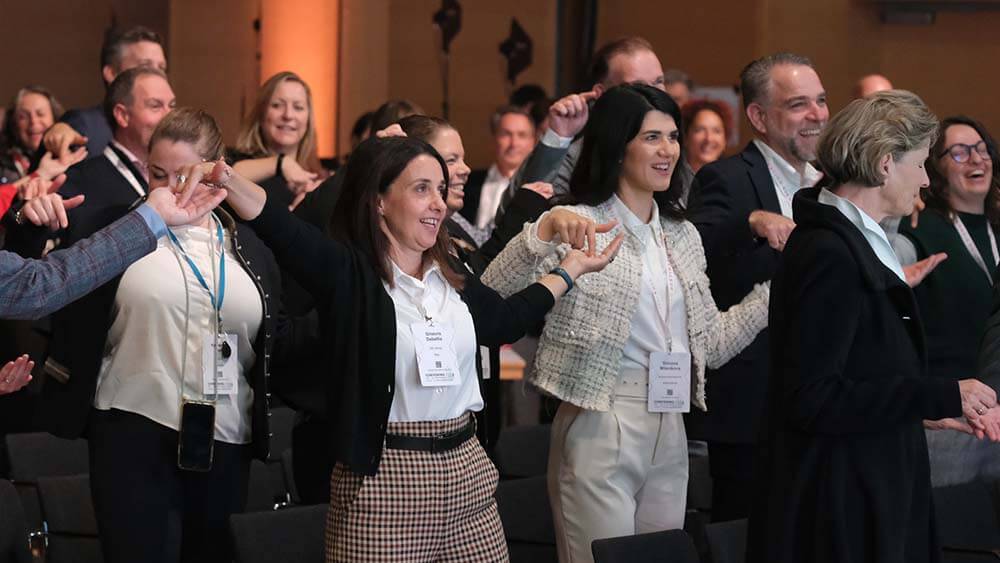
If organizers want people to come back to in-person events, those events must offer a compelling reason to make the trip, from interactive sessions to active collaboration. (Photos by Alexander Wieselthaler)

“What if we asked people to contribute to a collective outcome that moves the organizational strategic goals forward in some way?” — Beth Surmont
The other day somebody asked me if I could define what an event is. It’s an interesting question to consider, not only for understanding our current state, but also to give greater thought to what events can — and should — be going forward.
The definition of the word “event” is an occasion, a happening, an experience. But it also can be a result, a consequence, or an outcome. At this moment in time, let’s agree that we’ve evolved past the idea of an event as just a gathering of the community. Whether it’s a 20-person committee meeting or a 20,000-person trade show, the event is an opportunity for the host organization to advance its strategic initiatives. It is the expression of your value proposition IRL. An in-person event can make the features, benefits, and rewards of your organization tangible to your audience like no other kind of experience. It’s a launchpad and amplifier to advance your mission and accelerate your industry.
An event also is an opportunity to create an island of stability in a very uncertain time — a place where people who are struggling with real challenges and are seeking information can learn how to interpret rules, regulations, trends, forecasts, technology, and more. It’s a chance for them to talk with experts who are studying their issues and to share with peers facing the same challenges — just having the assurance that they are not alone carries so much weight.
Yet we continue to think about events almost exclusively through a content and logistics lens. We gather all this brainpower in one location, share research and information, show off our products, and leave it to the audience to come up with their own takeaways. This value proposition is no longer as compelling as it once was. Our audiences are now comfortable with getting that content through their computer screens, without navigating the logistics of travel. When people are weighing travel against their work and personal priorities, it’s easier to make the decision to stay home. If you want people to come back in person, you must give them a compelling reason to make the trip.
What if we asked people to contribute to a collective outcome that moves the organizational strategic goals forward in some way? What if we encouraged people to give some time on site to solving a problem facing their industry? This raises the stakes for in-person collaboration. Now there is something happening that they can’t participate in via a screen, and it also expands their sense of responsibility beyond just their personal priorities.
How to get there? Start with these four tips to level up the potential of your event to be truly participatory.
1. Understand the issues in your space. Look at the market forces that are affecting your organization through the lenses of the economy, regulations, and technology. Then, identify the key issues that are affecting your audience — and your audience’s audience. An afternoon spent reading a few reports and news articles can help you to identify challenges that your event participants can tackle.
2. Leverage your organization’s unique strengths — not just what you are good at, but what you can be the best in the world at. What is it that your organization can do better than anyone else? It may be who you have access to, perhaps it’s a special program you’ve created, or it could even be the timing of your annual meeting. Take time to think through how your strengths can be leveraged to enable your participants to have the greatest impact on industry issues.
3. Frame the right problem to solve. Whatever you decide to tackle should line up with your organizational strategy and goals. It should be highly relevant to your audience and align with your identified strengths. There should be clear ways that the audience can be actively involved in ideation, have access to decision makers, and contribute knowledge.
4. Create flexibility in your agenda. Your approach will look different across different types of events. For some, a problem-solving track will work well. For others, adding an outcome-based exercise to each session makes the most sense. Business trade shows may need to add a summit that draws an ancillary audience. STEM events could leverage the poster sessions in a new way. For example, some medical conferences have provided stickers and markers at a social activity and challenged attendees to sketch an element of their poster presentation and affix to their clothing — a mini poster — as a conversation starter.
It will take testing to determine the best approach for you to take, but remember this quote attributed to Nelson Mandela: “I never fail. I either win or I learn.”
Beth Surmont, CMP, FASAE, CAE, is vice president of event strategy and design for marketing, strategy, and experience agency 360 Live Media.
